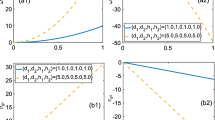Abstract
In this paper, the dynamical behaviors of a two-dimensional simplified Hodgkin–Huxley (H–H) model exposed to external electric fields are investigated through qualitative analysis and numerical simulation. A necessary and sufficient condition is proposed for the existence of the Hopf bifurcation. Saddle-node bifurcations and canards of the simplified model with the coefficients of different linear forms are also discussed. Finally, the bifurcation curves with the coefficients of different linear forms are shown. The numerical results demonstrate that some linear forms can retain the bifurcation characteristics of the original model, which is of great use to simplify the H–H model for the real-world applications.






Similar content being viewed by others
References
Hodgkin AL, Huxley AF (1952) A quantitative description of membrane and its application to conduction and excitation in nerve. J Physiol 117:500–544
Hodgkin AL, Huxley AF (1952) Currents carried by sodium and potassium ions through the membrane of the giant axon of Loligo. J Physiol 116:449–472
Hodgkin AL, Huxley AF (1952) The components of membrane conductance in the giant axon of Loligo. J Physiol 116:473–496
Hodgkin AL, Huxley AF (1952) The dual effect of membrane potential on sodium conductance in the giant axon of Loligo. J Physiol 116:497–506
Keener J, Sneyd J (1998) Mathematical physiology. Springer, New York
Cronin J (1987) Mathematical aspects of Hodgkin–Huxley neural theory. Cambridge University Press, Cambridge
Moehlis J (2006) Canards for a reduction of the Hodgkin–Huxley equations. J Math Biol 52:141–153
Wilson H (1999) Spikes decisions and actions: dynamical foundations of neuroscience. Oxford University Press, Oxford
Calitoiu D, Oommen BJ, Nussbaum D (2008) Spikes annihilation in the Hodgkin–Huxley neuron. Biol Cybern 98:239–257
Wang J, Geng JM, Fei XY (2005) Two-parameters Hopf bifurcation in the Hodgkin–Huxley model. Chaos Solitons Fractals 23:973–980
Wang J, Chen LQ, Fei XY (2007) Analysis and control of the bifurcation of Hodgkin–Huxley model. Chaos Solitons Fractals 31:247–256
Wang J, Chen LQ, Fei XY (2007) Bifurcation control of the Hodgkin–Huxley equations. Chaos Solitons Fractals 33:217–224
Qu JY, Wang RB, Du Y (2013) An improved selective attention model considering orientation preferences. Neural Comput Appl 22(2):303–311
Wang H, Yu YG, Zhao R, Wang S (2013) Two-parameter bifurcation in a two-dimensional simplified Hodgkin–Huxley model. Commun Nonlinear Sci Numer Simul 18:184–193
Izhikevich EM (2004) Which model to use for cortical spiking neurons?. IEEE Trans Neural Netw 15:1063–1070
Iren V, Natacha G, Frank T, Oxana L (2007) Modeling of inhibition/excitation firing in olfactory bulb through spiking neurons. Neural Comput Appl 16(4-5):355–372
Tomoki K, Kunihiko K (2012) Learning to memorize input–output mapping as bifurcation in neural dynamics: relevance of multiple timescales for synapse changes. Neural Comput Appl 21(4):725–734
Ricci G, Volpi L, Pasquali L, Petrozzi L, Siciliano G (2009) Astrocyte-neuron interactions in neurological disorders. J Biol Phys 35:317–336
Garbo AD (2009) Dynamics of a minimal neural model consisting of an astrocyte, a neuron, and an interneuron. J Biol Phys 35:361–382
Hiroshige T, Takako M, Yoshitaka N, Gerard BR, Yoshinobu G, Shozo T (2011) A neural decoding approach to auditory temporal assimilation. Neural Comput Appl 20(7):965–973
Wang H, Yu YG, Wang S, Yu JZ (2013) Hopf bifurcation analysis in a two-dimensional simplified Hodgkin–Huxley model. Appl Math Comput (submitted)
Wang H, Yu YG, Wang M, Zhao R (2010) The dynamical analysis of a two-dimensional simplified Hodgkin–Huxley model. IEEE ICNC 6:814–818
Callot JL, Diener F, Diener M (1978) Le problème de la “chasse au canard”. C R Acad Sci Paris (Sèr. I) 286:1059–1061
Benoit E, Callot JL, Diener F, Diener M (1981) Chasse au canard. Collect Math 32:37–119
Guckenheimer J, Hoffman K, Weckesser W (2000) Numerical computation of canards. Int J Bif Chaos 10:2669–2687
Krupa M, Szmolyan P (2001) Relaxation oscillation and canard explosion. J Differ Equ 174:312–368
Szmolyan P, Wechselberger M (2001) Canards in R 3. J Differ Equ 177:419–453
Izhikevich EM (2010) Dynamical systems in neuroscience: the geometry of excitability and bursting. The MIT Press, Cambridge
Acknowledgments
This work is supported by the National Nature Science Foundation of China under Grant No. 10901014 and No. 61075102, the Science Foundation of Beijing Jiaotong University under Grant 2011JBM130.
Author information
Authors and Affiliations
Corresponding author
Rights and permissions
About this article
Cite this article
Wang, H., Yu, Y., Wang, S. et al. Bifurcation analysis of a two-dimensional simplified Hodgkin–Huxley model exposed to external electric fields. Neural Comput & Applic 24, 37–44 (2014). https://doi.org/10.1007/s00521-013-1462-3
Received:
Accepted:
Published:
Issue Date:
DOI: https://doi.org/10.1007/s00521-013-1462-3




